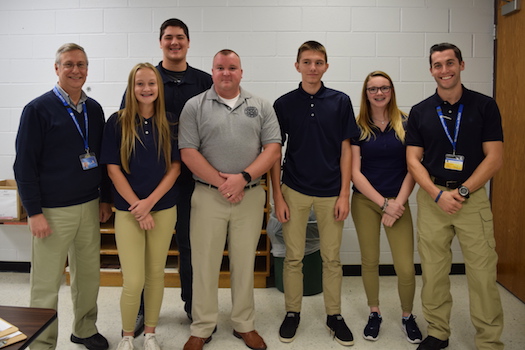Class learns about opioid epidemic with Narcan training

Provided photo: This photo shows some of the class members in the Security and Law Enforcement class at the Orleans Career and Technical Education Center. Pictured, from left: teacher Gene Newman, Megan Showler (Medina), Salvatore Gioeli (Royalton Hartland), Andrew Steel, Connor Miller (Medina) and Jessica James (Medina) and teacher Steve Browning.
Press release, Orleans/Niagara BOCES
MEDINA – Opioid overdoses are a growing nationwide concern with prescription drug and heroin abuse increasing across all demographic groups.
For the Security and Law Enforcement students at the Orleans Career and Technical Education Center, in their chosen career they will likely encounter someone suffering from an opioid overdose.
“This is a growing epidemic in our country,” says Security and Law Enforcement teacher Steve Browning. “We felt it was very important to bring in an expert to talk about it and who can show the students the proper way to administer Narcan, which blocks the opioid overdose effects. Law enforcement agencies are using this more and more.”
Andrew Steel, EMT-P/NRP with Lake Plains Community Care Network, spent some time with Mr. Browning’s and Mr. Gene Newman’s classes. Steel educated them on opioid overdoses and showed them how to administer Narcan, also known as naloxone, nasal spray.
“Unfortunately there are a growing number of people who are experimenting with drugs and are drug dependent,” Steel said. “Opioid overdoses are occurring in urban, rural and suburban areas on a daily basis. It is hard for these people to get help because there is a two year waiting list to get into rehab centers. We are trying to push out Narcan to the communities because it is turning into a pandemic. I also want to make the students aware that it is not only people who are using these drugs recreationally who can have an overdose. Sometimes elderly people, who are taking prescribed opioids, will forget that they already took their dose and take more causing them to overdose. I spend a lot of time talking to first responders on how to identify if someone is overdosing and what to do.”
Mr. Steel went over the signs and symptoms of an overdose with the students.
“Usually in an overdose you have a small window to respond and there is no time to waste,” he said. “You have four to six minutes until they die if they are not treated with Narcan.”
He assured the students they don’t need to fear helping someone who is overdosing thanks to the 911 Good Samaritan Law. The law protects the non-medical person from liability who administers naloxone. With a prescription people are allowed to carry 10 syringes.
“This device will equip community members, families, friends and caregivers with a tool they can use without medical training to save a life,” Steel said.









































































